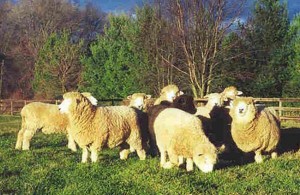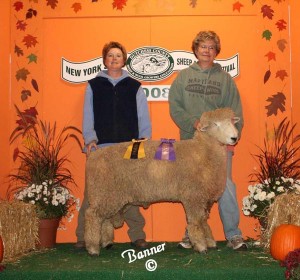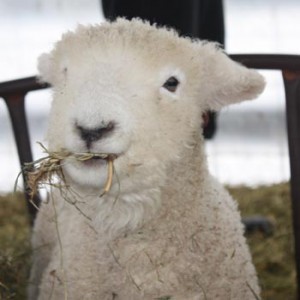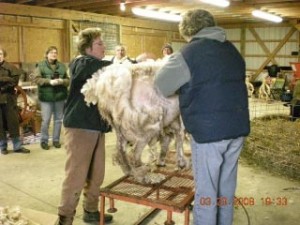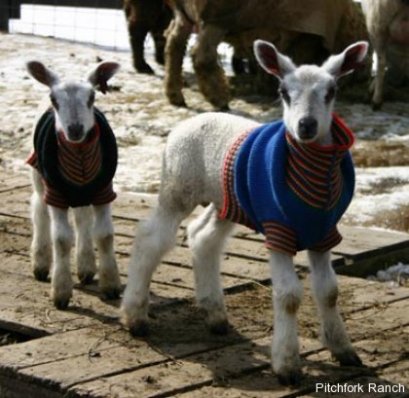Our Sheep Management Practices
There’s a wide variety of practices in the raising sheep — probably as many as there are breeders who raise them. All have their advantages and disadvantages, and all have specific goals (or at least should have). We are not passing judgement on any other breeders’ practices, nor do we believe that our practices are beyond improvement. We believe it important to state some of the more important aspects of our sheep management, even if the only result is that prospective buyers ask more questions of other breeders. Of course, our space and your time do not allow for excruciating detail here, just the more relevant information.
Lambing
We generally plan for lambing in January and February, with usually a few stragglers in March. We may use CIDRS to time
and group the deliveries in such a way that lambing will work for two people with full-time jobs. We prefer the early lambing in order to have a good number of lambs to take to the Maryland Sheep and Wool Festival, for which the birth cut-off is February 15. Early lambing also helps by encouraging creep feed consumption by the lambs, cutting the parasite challenge to young lambs and eliminating fly-strike on banded tails. Because of our Midwestern winters, we utilize a lambing barn setting for the vast majority of deliveries, although there’s always a few ewes who decide to follow their own schedule and lamb out in the open shed, no matter what our breeding records say.
We strive to assist lambing only when absolutely necessary. In very cold weather, we provide a heat lamp for the BFL lambs for the first 24 hours. We generally put the lambs out with their mothers after 4-5 days in the lambing barn. There is usually 5-12 inches of snow on the ground, with nighttime temps that can drop to below 0 degrees Farenheit (they are usually in the teens or 20s, however). The lambs are amazingly adept at adjusting to the cold as long as they have a spot to get out of the weather. We have a deep 3-sided shed open to all the sheep with a creep area for the lambs on one side. We begin providing creep feed to the lambs within 2 weeks of the first delivery, and soon they are slipping in to give it a try.
Flock Health
We have a vet on call, but try to do as much as we can on our own. After attending a ovine parasite workshop held by the MSU Extension led by MSU food animal vet Dr. Earnhardt and learning to do fecal float tests, we feel greatly empowered in controlling intestinal parasites in our flock while avoiding the wormer resistance in our local worm populations. Between on-farm fecals and FAMACHA, we have virtually eliminated blanket wormings on our flock, saving money, time, and stress.
We test for OPP on a 10-15% of our flock every year. Cindy’s nursing skills have helped greatly in this, as she is skilled at drawing blood. We also work to maintain a number of older ewes in the flock to act as our “canaries in the coalmine” for this particular disease. So far, all tests have returned negative.
We are in our 4th year of compliance of the voluntary Scrapie Flock Certification Program (SFCP). As a result, we have closed our ewe flock in both Romneys and Bluefaced Leicesters for all practical purposes.
Breeding stock
We are committed to breeding purebred stock, and working on improvements from within the breed through careful selection of outside rams, artificial insemination, thoughtfully planned breeding groups, robust fencing and judicious culling. Our sheep, while good-sized, may not be the largest or tallest animals in the showring at the bigger shows. They will exhibit all the characteristics intrinsic to the breed. As is stated elsewhere on our site, we do not confine indoors any sector of our flock, show flock or otherwise. All our sheep are at liberty to move between pasture and shed, and are selected to do well in the wide variety of weather for which the Midwest is famous. We use no growth hormones with any of our sheep. We do not restrict their diets to achieve a certain look for the showring.
We select for reproductive success (fertility, ease of lambing, twinning, mothering ability, good udders), growth and maintenance (good rate of gain in lambs, easy keepers on grass as adults), conformation (legs, pasterns, topline, length of loin, capacity, teeth, etc.) and breed standard (black points on Romneys, blue skin on the BFLs, traditional fleeces, etc.)
Flock nutrition
We are located in the Upper Midwest, and are subject to both the benefits and the drawbacks of such a location.
We actually love our harsh winters; they help keep out the riff-raff, as we like to say (year-round parasite loads, fire ants, alligators, Spring-Breakers and other such undesirables). However, they make it necessary to feed hay and grain. Fortunately, both are in relatively good supply in our region. So, naturally, we use them as a significant part of our flock’s diet when we have inadequate forage, which is pretty much from Thanksgiving through Easter, give or take. For grain, we use a recipe originally developed by Michigan State University, fined tuned by us over the years, custom mixed at our grain elevator. For hay, we have our alfalfa field custom-baled (small squares) for us by a local farmer. In a good year, we’ll get three cuttings. For optimal growth, the lambs are grained to some degree (in diminishing amounts) until they are yearlings. After that, it is grass or hay as needed for maintenance. Adults are given a small amount of grain for flushing prior to breeding, and appropriate amounts during late gestation and high-volume lactation, along with adequate hay (normally second cutting alfalfa). At weaning, we pen the ewes so that the lambs can have access to them for a short (3-5 day) drying off period, and feed them only low nutrient hay. In this way, the lambs help remove the excess milk while lactation slows in response to the drop in nutrition. When we finally remove the ewes to their post weaning pasture, we sometimes give a dose of dry cow antibiotic in each side of the udder. We end up with minimal cases of mastitis (in most years, none.)
Shearing
We do our own shearing, on our own schedule. Since we sell most of our fleeces to handspinners, this means shearing when the fleeces are prime and ready (4.5 to 5.5 inches) and the ewe will be able to cope with both the act of shearing and the loss of her fleece. It also means that we do not shear all our ewes at the same time. We have them staggered so that around four to eight will need shearing around the same time. We also do our own crutching (shearing around the rear and udder in anticipation of lambing) for those ewes that will be carrying more fleece at lambing time. Though we try to avoid it, we sometimes have a heavily pregnant ewe or two carrying a full fleece. In those cases, we will wait until after she delivers and shear her before she leaves the lambing barn.
We shear from the trim stand. This is a great method for those not formally trained in sheep shearing. It allows us to remove the prime fleece, skirt it and box it all at the same time. It is a low-stress method that works well even on pregnant ewes. This method will not win any speed records (it takes us 15-20 min start to finish per sheep, which includes foot trimming and fleece handling), but it works for us.
We have nothing against professional shearers. Most do a great job. However, for us, our DIY “shear through the year” method has served us well, and we’ll continue it as long as we can. We do bring in a shearer to take care of our mature rams.
23,180 views
